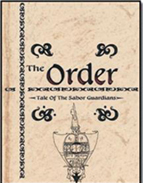
 |
Young Sabor Lindon, a son of a law enforcer, is supremely happy. He is engaged to a pretty young girl and is happy living with his parents, except for a strange rash emerging on his arms. But his world is soon torn apart by a mysterious, evil being called Dvanken. This embodiment of evil feeds off the negative emotions of humans and so targets those who suffer from grief, pain, rage, and despair. Dvanken targets Sabor's family, destroying his father, his fiancé, and various other humans who wallow in emotional pain. Sabor finds that his promised twenty-two year old birthday means much more than he expects, as he learns that his father died in the service of a mysterious Order, of which he is now to be inducted. This Order is dedicated to the destruction of the evil Dvanken, and when a pair of saber-like blades (here called sabors) burst from his arms, he knows that his life is taking a new turn. His uncle introduces him to a secretive complex where members of this Order, descendants of generations of evil-fighters, all of whom have inner sabors, reside and train to fight evil. Dvanken has been in existence for thousands of years, emerging from the biblical Cain, in fact. Sabor's special role in this battle becomes apparent to him, and so he steels himself against numerous challenges and obstacles on his journey to become equal to the task of defeating Dvanken.
The narrator is the lone survivor of a race of Gargoyles who once lived on the earth but were vanquished in the war with Dvanken, and who, in the mundane world, was actually a stone gargoyle that stood outside the young Sabor Lindon's balcony as a guardian. Told in short, episodic vignettes, the battle between good and evil is given a new twist, the writer's fecund imagination apparent in his world-building and easy transposition between the prosaic and the fantastic. The theme is mostly how emotional resentment, pain, and bitterness leave one open to destruction and sorrow, and the need to transform them into forgiveness and acceptance. The plot is intricate, with a large number of imaginative characters and fantastic settings. The author also provides excellent maps and character sketches that help visualize the setting and characters. Unfortunately, the telling is marred by very irregular punctuation, occasional misspellings, and not a few sentence fragments. However, the yarn is extremely imaginative and a rather impressive production.